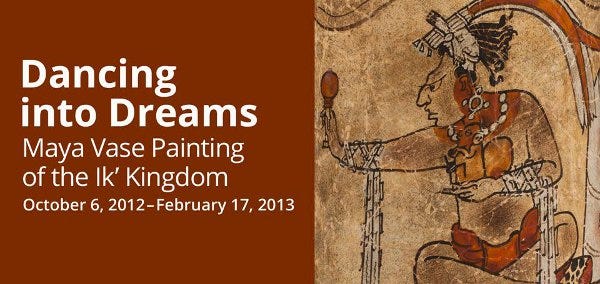Visions of the Everyday
“Dancing Into Dream, Maya Vase Painting of the Ik’ Kingdom”
Princeton University Art Museum
Runs Oct. 6, 2012 to Feb. 17,2013

Dark against the glazed orange background, fat and sparsely clothed men sit cross-legged and gesture at each other. Kings sit in the shade entertained by dwarfs and dancers, also solidly built and adorned with feathered costumes, who stand frozen in the midst of a step. Two figures confer with each other, ensconced in a hieroglyphic band while, next to them, an unnaturally tall man watches another hurl himself at a circular object. From each of these scenes emanates a stark, inescapable otherness.
Of course, that is to be expected from painted scenes on Mayan vases. Yet this otherness is not the distinguishing feature of “Dancing Into Dream, Maya Vase Painting of the Ik’ Kingdom,” a small new exhibit at the Princeton University Art Museum. Rather, these vases are striking because, for the most part, their scenes are not — or at least were not meant to be — weird or mystical. Rather, these scenes for the most part portray the traditional customs and figures of the court, reflecting the lives of the kings and nobles.
While the mysteriousness of these vases is particularly striking, their purpose was not to remain mysterious for long. They had a very social use, in fact. These vases were used to serve frothy chocolate at grand dinners at the court, and their scenes were meant to spark conversations. As a result, the scenes on the vases are closely linked to life at the court. The fat, cross-legged men are nobles, possibly gossiping about the latest events at the court. The dancers are simply providing entertainment for the king. The man throwing himself at the circular object is playing a ball game. And the vases contain many other such scenes: dinners, audiences, meetings of noblewomen, and so on.
It is always strange to think of lost civilizations as having “everyday life.” It is always easier to focus on their otherness and not to think of what their artifacts were meant to be initially. This exhibition art reminds the viewer of the truly public function of art. The Ik’ kingdom probably had mysterious art created for religious ceremonies. In fact, there are two vases that depict demons in the current exhibition. But the majority of these vases were simply used as light entertainment during the meal. These vases therefore make the strange Ik’ kingdom almost familiar, for they make the viewer consider not only their mystery but, more importantly, their connection with the daily life of a group of people.